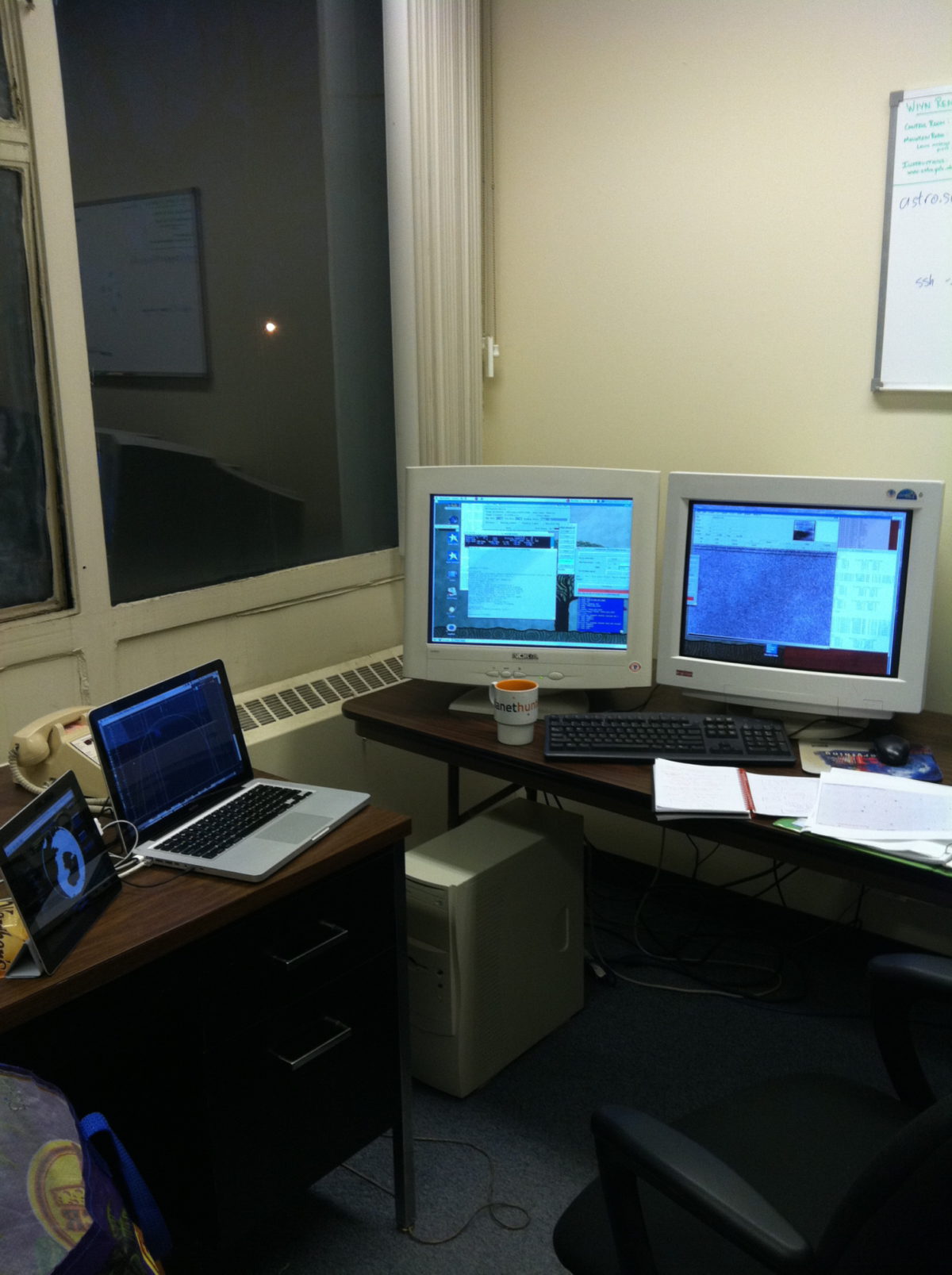Meg Schwamb • Jun 08, 2011
Observing at the WIYN
Meg Schwamb is a National Science Foundation postdoctoral fellow at Yale University. She's currently searching for previously unseen Kuiper belt objects in the southern skies with the La Silla-QUEST KBO Survey and is hunting planets in Kepler data with the Planet Hunters project. --ESL
Emily and I thought it would interesting to talk a bit about observing on large telescopes. On May 5 and 6, I had a run on the WIYN (Wisconsin-Indiana-Yale-NOAO) telescope, a 3.5 m telescope, the second largest telescope on Kitt Peak in Arizona. For those nights, I was attempting to observe a "mutual event" of dwarf planet Haumea and its inner moon Namaka, when Namaka passed in front Haumea. When Namaka crosses Haumea, it blocks some of Haumea's light, so there's a drop in the apparent brightness of the pair.

With precise timing of the exact moment when the moon crosses the edges of the dwarf planet you can get an exquisite measurement of Haumea's size. There are many of these evnets, one for each of Namaka's orbits of Haumea, so each one measures a single path along Haumea. If we can successfully observe many such tracks, we can create a map of Haumea's three-dimensional shape. These mutual events are being observed by a collaboration of observers led by Mike Brown at Caltech. For more about the Haumea/Namaka mutual events, check out Mike's website.
We'd like to observe all of these mutual events, but we can't. Time on large telescopes is precious. It is expensive for universities to run these large facilities. For example, it costs about a dollar a second to operate the Keck telescopes (the large 10-meter telescopes on Mauna Kea). Many observatories and telescopes operate jointly, with several universities pooling their resources, and their astronomers sharing time on these telescopes.
Twice a year, astronomers get to send in observing proposals competing for the nights available. In these proposals you explain the project you want to do, why it is interesting, and why you need that specific telescope (for instance, why you need 10-meter-class telescope like Keck rather than a 3.5-meter like WIYN). Then the Time Allocation Committee (TAC) reads all the proposals for a telescope and decide which proposals will be selected and how many nights they will get. Last fall, I put in a proposal with Mike Brown and Darin Ragozzine to try and observe 3 of the Haumea events using WIYN, and it was accepted by the Yale TAC. [Note: I wrote about Darin's participation in this project here. --ESL]
If your proposal is accepted, then you get to do the fun the challenging part, gathering your data. The TAC grants you specific nights on the telescope, so if it's cloudy, raining, or the instrument breaks, you don't get a do over. If it's cloudy and you need clear skies, you just have to deal with the night the best you can, and apply again the next semester or year after (always wish an observer clear skies!). I've gotten into the habit of watching the weather report and satellite maps the days before and especially the day of my observing runs. It's a bit like reading tea leaves, trying to forecast whether the clouds will move out before sunset, will you have clear skies, or will it rain and you won't even open the dome. For my WIYN observing run, the skies cleared an hour or so after sunset. I was able to observe the mutual event, and hopefully I'll see the drop in Haumea's light once I reduce the data.

When you think of an astronomer, you might imagine someone who spends her nights in the cold dark dome observing and moving the telescope. Actually, we mostly spend our nights observing from a separate control room. There's a telescope operator who drives the telescope for you. The astronomers are usually hunched over a computer screen as the next image taken by the camera is downloaded and displayed. We use computer interfaces to control the camera or spectrograph and examine the images.
The control room is usually next to the telescope; for example, on the Subaru telescope, the control room is in the building next to the dome on Mauna Kea. But sometimes you're not even on the mountain, and in some cases you're very very far away from the telescope. Observers for the Keck telescopes can observe from California or Connecticut, and those that do travel to Hawaii observe remotely from sea level, not at the brain-addling high altitude of Maunea Kea. For this WIYN observing run, I observed from New Haven, controlling WIYN from a computer at Yale. On the computer at Yale I see all the same screens I'd have if I was in the control room at Kitt Peak. I can even see the operator controlling the telescope on video chat.
Although most of our time is spent inside telling the operator where we want to point next and taking the observations, at some point during the night, I'll sneak out and stare out at the night sky. Usually I'm going out to check the sky conditions and the weather, but I'll try and stay out there as long as I can. Just taking it in and staring in awe, I'm always amazed at the number upon numbers of stars and how beautiful the galaxy is. In those moments, in the cold and quiet on the mountain, I remember why I have one of the best jobs in the world.

Support our core enterprises
Your support powers our mission to explore worlds, find life, and defend Earth. You make all the difference when you make a gift. Give today!
Donate

 Explore Worlds
Explore Worlds Find Life
Find Life Defend Earth
Defend Earth

